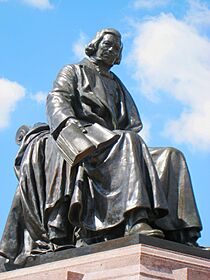William Marsh Rice facts for kids
Quick facts for kids
William Marsh Rice
|
|
|---|---|

Engraving of Rice
|
|
| Born | March 14, 1816 |
| Died | September 23, 1900 (aged 84) New York City, U.S.
|
| Occupation | Businessman |
| Known for | Namesake of Rice University |
William Marsh Rice (born March 14, 1816 – died September 23, 1900) was an American businessman. He left most of his money to start Rice University in Houston, Texas. Rice died under suspicious circumstances. His death led to a legal battle over his will. This battle helped make sure his dream of a university came true.
Contents
Early Life and Business Beginnings
William Marsh Rice was born on March 14, 1816. He grew up in Springfield, Massachusetts. He was the third of ten children in his family.
At age 15, William started working in a grocery store. By the time he was 22, he owned the store. Around 1837, he moved to Texas. He was looking for new business chances. He first worked as a bartender in Houston.
After losing his goods at sea, Rice started over as a clerk. Soon, he opened a general store called Rice and Nichols. This store was the start of his successful business career.
Building a Fortune
Rice became very wealthy by investing in many things. He bought land, real estate, and lumber. He also invested in railroads and cotton. His businesses were mainly in Texas and Louisiana.
By 1860, his property was worth a lot of money. He owned many business firms in Houston. In 1895, he was known as a "Capitalist." He owned the Capitol Hotel and was president of the Houston Brick Works Company. Rice was also a member of the Independent Order of Odd Fellows.
Rice married Margaret Bremond in 1850. She was from Houston, Texas. Margaret died in 1863. Rice later married Julia E. Brown in 1867.
Rice lived in Houston for many years. Around 1865, he moved to New York. He later built a home in Dunellen, New Jersey. In 1882, he moved back to New York.
Founding a University
William Rice wanted to use his wealth to help others. In 1882, he wrote a will. He planned to create "The William M. Rice Orphans Institute." This would be a place for children without parents.
Later, Rice changed his mind. He decided to found a different kind of school. In 1891, he chose to create the William M. Rice Institute. This school would be for "the Advancement of Literature, Science and Art." He wanted it to be in Houston, Texas. This was the city where he had made his fortune.
The official document for the Institute was signed in May 1891. It was certified by the State of Texas. William Marsh Rice also gave land to the city of Rice, Texas.
William Marsh Rice's Legacy

William Rice left most of his money to start a free university. It opened in 1912. It was first called the William Marsh Rice Institute. Today, it is known as Rice University.
In his will, Rice said the university was for "white men and women of Houston." However, this rule was later changed. In 1964, Raymond L. Johnson became the first Black student at Rice University. This opened the doors for all students.
The Rice School in Houston is also named after William Marsh Rice.
Images for kids
-
Statue of William Marsh Rice at Rice University, sculpted by John Angel.



